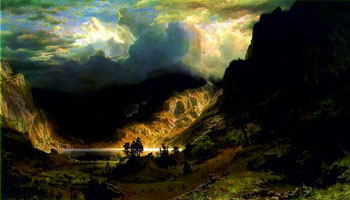| Search Art Prints | ||||||||||||||||||||
| Search Artists | ||||||||||||||||||||

|
||||||||||||||||||||
|
|
|||||||||||||||||||

A Storm in the Rocky Mountains - Mount Rosalie

|
A Storm in the Rocky Mountains - Mount Rosalie
‘A Storm in the Rocky Mountains - Mount Rosalie’ is regarded as one of Albert Bierstadt’s most ambitious portrayals of the Rocky Mountains. In 1863, the artist set out on an expedition to the Chicago Lakes region of the Rockies accompanied by Fitz Hugh Ludlow (New York Evening Post art critic) who documented his travels. He wrote “We were going to the original site of the Garden of Eden”, the artist’s reference to Yosemite.
Once the party arrived at their intended destination, William N. Byers (editor - Denver's Rocky Mountain News) escorted them through the region currently known as the Chicago Peaks Range. Some time into their journey, Albert Bierstadt came to an immediate halt in awe of the breathtaking view, and began to make sketches of the mountainous landscape. In Byers article ‘Bierstadt's Visit to Colorado’, (Magazine of Western History 11 Jan. 1890), he shares the events that inspired the painting. Byers states, “Bierstadt said it would take him 15 minutes, fumbling for his paints without taking his eyes off the view… storm clouds were sweeping across the great chasm from northwest to southeast. Rays of sunlight were breaking through the broken, ragged clouds and lighting up in moving streaks the falling storm. Bierstadt worked as though inspired. Nothing was said by either of us….. The glorious scene was fading as he packed up his traps. He asked: "There, was I more than fifteen minutes?" I answered: "Yes, you were at work forty-five minutes by the watch!" As thunderclouds threatened to turn day to night, a beacon of light broke through illuminating the base of the valley below where the Indians sought to find cover.
Illuminated panoramic views of Western sceneries were the epitome of American nineteenth century landscape painting. Many artists, including Albert Bierstadt of the Hudson River School of art used Luminism, a neo-impressionist style in painting, to convey the breathtaking beauty of landscape art.
Albert Bierstadt christened the glorious peak Monte Rosa (Mount Rosalie), after Ludlow's wife Rosalie, who would later divorce her husband and marry the artist. When the artist returned to New York, he took a little over 2 years to produce the magnificent painting ‘A Storm in the Rocky Mountains - Mount Rosalie’ (1866).
The painting was first exhibited in New York (1865-6), and the proceeds from admission, which were donated to a charity for the destitute soldiers’ orphans, attracted great attention and endless criticism. A year later, in 1867, ‘A Storm in the Rocky Mountains - Mount Rosalie’, along with another of the artist’s landscapes that featured the Rocky Mountains, were exhibited in a world exposition that travelled through London and Paris. Nancy K. Anderson (Art historian) critiqued the artist’s work as a “near-perfect combination of technical expertise, European experience, national enthusiasm and marketing savvy -- everything required to turn the Western landscape into an iconic image of national definition.” ‘A Storm in the Rocky Mountains - Mount Rosalie’ sold for $20,000. Chromolithographs reproductions were produced until its mass production caused manufacturers to use cheaper materials.
‘A Storm in the Rocky Mountains - Mount Rosalie’ found its home in the Brooklyn Museum, New York (1991). On February 15th 1991, the painting was featured in ‘Albert Bierstadt: Art and Industry,’ a retrospective of the artist’s work.











